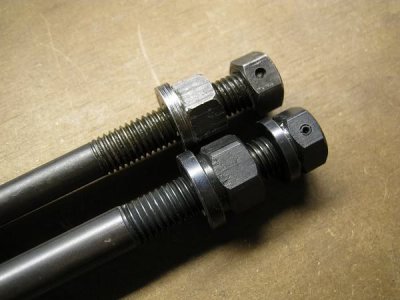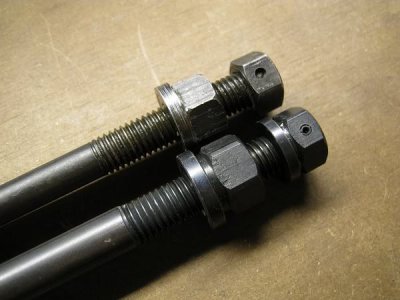Hi Guys
This is quite embarrassing, but we have to get it out in the open and rectified.
Whilst working with our Asian BP clone we left the Spanner, some of U Guys call it a wrench, in the DRAWBAR and turned the machine on without realising what we had done. Definitely was not intentional as we were totally engrossed in the problems with the job at hand. Well crash boom bang !!! ~!@#$%^&*()_+{ This was a first and a shocker for us !!! Had a Millwright remove the stuck DRAWBAR, albeit he could not trace any serious damage nor reduce the noise in High Speeds. Regrettably this happened a second time and we managed to remove the DRAWBAR ourselves, seemingly without having done too much damage ???
However, having now acquired a nice GMT R8 Integral Keyless Chuck which we tried in the machine today, we noticed that the DRAWBAR had to be SCREWED really deep to fully engage in the Spindle. With a drill bit mounted in this new Chuck, it ran beautifully true visually, without being clocked, in direct contrast to the last Fong Kong one we had to return to the local Supplier. Reading some other threads here as well we note that some of the original BP Drawbars have WASHERS etc.
Now the obvious questions that need be addressed here would be :-
1. How much and what damage have we done to the Machine ???
2. Would using Washers resolve our deep threading problem ???
3. Would we need to re-open the complete top of the Machine Head to access intricate Parts ???
4. Have we crushed any Bearings above the Spindle, although the Spindle seems to be functioning normal ???
5. And finally, what would be the best bet in eliminating such a recurrence, without having to change the complete HEAD and installing an AUTO FEED, like the later Models. ( Or changing the Operator !! )
We could take pics and upload if necessary. However, we must make it very clear here that we will definitely not be able to take chances and attempt any mechanical corrections as that would be way beyond our meagre capabilities. It would be obvious from these incidents that we are indeed rookies trying to get work done on a sophisticated machine without prior training or qualified Supervision. We would love to restore our Machine to its original smooth quiet running, even if we have to solicit professional help.
Your advices would be immensely appreciated.
aRM
This is quite embarrassing, but we have to get it out in the open and rectified.
Whilst working with our Asian BP clone we left the Spanner, some of U Guys call it a wrench, in the DRAWBAR and turned the machine on without realising what we had done. Definitely was not intentional as we were totally engrossed in the problems with the job at hand. Well crash boom bang !!! ~!@#$%^&*()_+{ This was a first and a shocker for us !!! Had a Millwright remove the stuck DRAWBAR, albeit he could not trace any serious damage nor reduce the noise in High Speeds. Regrettably this happened a second time and we managed to remove the DRAWBAR ourselves, seemingly without having done too much damage ???
However, having now acquired a nice GMT R8 Integral Keyless Chuck which we tried in the machine today, we noticed that the DRAWBAR had to be SCREWED really deep to fully engage in the Spindle. With a drill bit mounted in this new Chuck, it ran beautifully true visually, without being clocked, in direct contrast to the last Fong Kong one we had to return to the local Supplier. Reading some other threads here as well we note that some of the original BP Drawbars have WASHERS etc.
Now the obvious questions that need be addressed here would be :-
1. How much and what damage have we done to the Machine ???
2. Would using Washers resolve our deep threading problem ???
3. Would we need to re-open the complete top of the Machine Head to access intricate Parts ???
4. Have we crushed any Bearings above the Spindle, although the Spindle seems to be functioning normal ???
5. And finally, what would be the best bet in eliminating such a recurrence, without having to change the complete HEAD and installing an AUTO FEED, like the later Models. ( Or changing the Operator !! )
We could take pics and upload if necessary. However, we must make it very clear here that we will definitely not be able to take chances and attempt any mechanical corrections as that would be way beyond our meagre capabilities. It would be obvious from these incidents that we are indeed rookies trying to get work done on a sophisticated machine without prior training or qualified Supervision. We would love to restore our Machine to its original smooth quiet running, even if we have to solicit professional help.
Your advices would be immensely appreciated.
aRM


